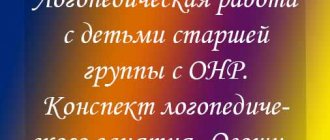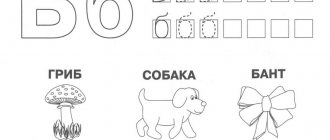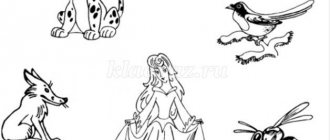Introducing the sound A
Summary of a frontal lesson on sound pronunciation and preparation for teaching literacy on the topic “Sound [a], letter A”
Target:
acquaintance with the sound [a], with the letter A.
Objectives:
- to introduce children to the sound [a], its characteristics: - to give an idea of the location of the sound in a word (the beginning of the word); - introduce the letter A, consolidate its visual image; - introduce the difference between a sound and a letter; - develop auditory attention, phonemic perception; - develop articulatory and fine motor skills; - learn to isolate a sound from a number of vowel sounds.
OD progress
1. Report the topic of the lesson.
— Guys, our guest today is a parrot named Archie. He has prepared a task for you: Listen and name the first sound in the words: bus, antenna, watermelon, acrobat. - That's right, the sound [a] is heard. The sound [a] is a vowel, it can be sung because the air passes freely and does not meet any obstacles. The sound [a] lives in the red castle of Princess Glasa. The sound [a] is indicated in red because it is a vowel. — Imagine a picture: a child is crying. What sound does he make when he cries? (sound [a]) - Correct. And today in class we will talk to you about the sound [a].
2. Clarification of sound articulation.
- Let's say the sound [a] together. When pronouncing the sound [a], the lips draw a large circle. Let's say the sound [a] again. Well done. - Now look, I have a red square in my hands - this is a symbol of sound [a] (showing the symbol of sound - a large red square) This is how we will designate it.
3. Game “Catch the Sound”
- So, guys, you will need to catch the sound [a]. When you hear it, raise the red square and clap your hands: a, u, o, a, y, i, a, e, u, a.
4. Game “Long - short”
I have two strips: one long, the other short. If I show a long strip, then you need to sing the sound [a] for a long time, and if I show a short strip, you need to sing it briefly.
5. Physical exercise.
“Cake”
We remember the dough with our hands (we squeeze and unclench our fingers)
Let's bake a sweet cake (as if we're kneading dough)
Lubricate the center with jam (circular movements with palms)
And top with sweet cream (along the plane of the table)
And coconut crumbs
We'll sprinkle the cake a little. (“sprinkle crumbs” with the fingers of both hands)
And then we’ll make tea,
Invite a friend to visit.
6. Work on handout sheets.
— Guys, Archie brought some sheets of assignments for you. Look at the pictures carefully and name them. Circle the pictures whose names begin with the sound [a]. - Well done, the names of these pictures begin with the sound [a].
7. Introducing the letter A.
- Guys, look at what I have pictured. This is the letter A. Guys, remember, the sound [a] in the letter is indicated by the letter A. The letter A is tall and slender. It looks very much like an arch. - Find the letter A on your piece of paper in the upper right corner. Run your finger over it (circle) and color it with a red pencil. Why red, who can tell me? - Because the sound [a] is a vowel and we denote it in red. - Listen to the rule of difference between sounds and letters: we hear, pronounce and sing sounds, but we write, see and read letters. - Let's try to make the letter A from our fingers. Letter A from fingers: the index and middle fingers of the right hand are lowered down, the rest are clenched into a fist, and the index finger of the left hand forms a “belt”. - So, now let's write the letter A with your finger in the air, on the table.
Summary of the lesson.
— Guys, who came to our lesson today? (parrot Archie) - Name the first sound in his name A - a - Archie (sound [a]) - Today we became acquainted with the sound [a]. - What letter did we meet? A. - What color indicates the sound [a]? red. — What did you like most? - Well done, you studied well today, listened carefully, answered questions. - Let's say goodbye to Archie the parrot. - Our lesson is over.
Target.Teach children to isolate the sound [a] in a stressed position at the beginning of a word; start introducing vowel sounds; practice expressive pronunciation of words, the ability to determine the sequence of sounds in onomatopoeic words; focus on the plane of the sheet (direction from top to bottom); draw straight lines from top to bottom; familiarize yourself with the image of the letter Aa.
Equipment.
A set of pictures and toys, panels of letters; individual sheets of white paper with clouds drawn at the top, pencils for each child; sound houses.
Progress of the lesson
I. 1. The teacher tells the story, highlighting (drawing out) the sound [a] in the words with his voice.
- I'll tell you about one dog. She was looking for a friend. The dog wandered down the street and looked into the eyes of passers-by. But no one paid attention to her. A girl ran past with a bouquet of asters. One flower fell. The girl was in a hurry and did not notice the loss. The dog took the flower in its teeth, caught up with the girl and placed the aster in front of her. The girl smiled and said: “Come with me!” The dog was happy and ran after the girl. This is how a homeless dog found a friend.
The girl's name was A-nya. She named the dog A-lyy, because the a-stra that the dog picked up was A-lyy.
All these words, A-nya, A-ly, a-stra, a-laya, begin with the same sound. When I spoke the words, I emphasized this sound.
Name this sound ([a]). Repeat words with the sound [a].
Articulation of sound. When we pronounce the sound [a], the mouth is wide open, the tongue lies behind the lower teeth. The sound is pronounced with the voice. The air stream does not encounter any obstacles on its path.
We will call sounds that are pronounced with the voice and do not encounter obstacles in the mouth as vowels. We will mark the windows in the sound houses where vowel sounds live in red.
Characteristics of sound. The sound [a] is a vowel.
2. - I will name the words. And you repeat them, emphasizing the sound [a] with your voice; the sound is at the beginning of the word: August, address, iceberg, stork, arch. (If necessary, enter an explanation of the meaning of words by the children, and clarification by the teacher)
II. 1. — Our Scarlet barked in a special way. His bark always began with the sound [a]. Guess how he barked: yap, aw, woof? (av).
2. - What is the first sound heard here? ([A]). Sequencing sounds using a sound house. The house has two windows; The first window is red.
3. - Dogs bark in different ways: some loudly, others quietly, some plaintively, others cheerfully. Show how Scarlet barked in the following situations: when he was happy with Anya (loudly), when he was afraid to wake up the owners (quietly), when he was lazy (slowly), when he was chasing the neighbor’s dogs (loudly and often).
III. 1. Getting to know the image of a letter.
- What sound did we meet today? ([A]). I will show you a letter sign that represents the sound [a]. (Show the letter) All letters will live in our group, in their own house. (Showing panels of letters) This house has six floors, each floor has 5-6 apartments. The letter Aa lives at the address: sixth floor (topmost row), apartment No. 1. (Children, with the help of the teacher, find the desired square on the panel and attach the letter to it)
2. Analysis of the letter image.
The teacher examines the letter with the children and asks:
— How many elements are in a letter? (Three) What elements? (Sticks) Are all sticks the same? (No. Two sticks are long, one is short.)
The teacher invites the children to verify the correctness of their observations. Working with scissors. Children cut up the letters given to them. Place the resulting elements in a row. They repeat which elements and in what quantities are needed to obtain the image of the letter A.
3. Letter synthesis.
The teacher offers to form the letter A again from the received elements.
4. The teacher suggests identifying the missing element of the letter. (The letter A has lost one long stick)
"A" ran along the path
And she broke her leg.
IV. Exercise “It’s Raining” to develop orientation on a sheet of paper and reinforce the direction from top to bottom.
“It’s time for us to say goodbye to the girl Anya and her new friend, the dog Scarlet.” They helped us a lot. We introduced them to the sound [a] and the letter A. Anya and Aly are in a hurry to go home, as it is raining outside. (Children take sheets of white paper and pencils)
— Drops from the clouds flew to the ground. Where are the clouds? (Above) How does it rain? (Down) Rain comes from top to bottom Let's draw autumn rain.
Children draw rain (straight vertical lines). The teacher makes sure that their movements are directed from top to bottom. Children can accompany actions by quietly pronouncing words from top to bottom.
Summary of a literacy lesson in the senior group
Summary of a literacy lesson in the senior group “Introduction to the sound “A” and the letter “A”
(First year of study)
Program content:
1.
Develop the skill of clearly pronouncing the sound “a”.
2.
Learn to isolate sounds from a series of vowels.
3.
Develop auditory attention.
4.
Introduce the letter "A".
5.
Develop fine motor skills.
Materials:
Doll, plot picture “Girl rocking a doll”, symbol (card) of the sound “A”, red circle, card with the letter “A”
(from the alphabet), sticks, workbook, colored pens.
I. Organizational moment
- The one who names the sign of autumn will sit down.
1.
Finger gymnastics “Autumn leaves scattered”:
Autumn scattered leaves, wave-like movements with palms.
I decorated them with a brush . Smooth strokes of the palms up and down.
We will go to the autumn park, “Walking” with the fingers of both hands.
We will collect leaves into bouquets. Cross your palms with your fingers spread out.
A maple leaf, a leaf from an aspen tree, Bend your fingers one by one, starting with
Oak leaf, rowan leaf, large, on both hands at the same time
A red poplar leaf for each leaf.
He jumped down onto the path. They clap their hands loudly.
2.
- Guys, we have a doll visiting us today. Her name is Ann. She has prepared a task for you.
Listen and name the first sound in the words:
arch, antenna, watermelon, acrobat.
- That's right, the sound “A” is heard. This is a vowel sound, it is sung and we don’t feel any obstacle in our mouth when we pronounce it. Look at the picture: a girl rocks a doll and sings “AAAA” to it.
II. Main part.
3.
Articulation of sound.
- Let's make a sound
"A".
Open your mouth wide
We gently rock the doll. (Pronounced individually and in chorus, with different voice strengths - quieter, louder.)
4.
– Look at the pictures carefully and name them.
(Work in Konovalenko’s notebook).
— Circle the pictures whose names begin with the sound “A”.
- Well done, the names of these pictures begin with the sound “A”.
5.
- The task was completed. Now look, I have a red circle in my hands - this is a symbol of the sound “A”. This is how we will designate it.
6. Game “Clap your hands when you hear the sound “A”:
a, y, o, a, s, i, a, e, y, a.
6.
Introducing the letter "A".
— Listen to the poem:
The letter A is tall and slender.
It looks very much like an arch.
- Look at the letter “A”. (A card with the image of the letter “A” is displayed).
- Find the letter “A” in your notebook, in the upper right corner. Run your finger over it (circle) and color it with a red pencil. Why red, who can tell me?
- Because the sound “A” is a vowel and we denote it in red.
7.
“You’ve worked hard and your fingers are tired, let’s stretch them.”
Finger gymnastics “We shared an orange.”
— See how you can form the letter “A” from your fingers:
The index and middle fingers of the right hand are lowered down, the remaining fingers are clenched into a fist, and the index finger of the left hand forms a crossbar.
Let's try to put it together.
8.
Laying out the letter “A” from sticks, drawing in the air.
9.
Print the letter "A" in your notebooks.
Sh.
Summary of the lesson, assessment of children.
- Guys, remember what sound we met in class today?
- With what letter?
- What color do we use?
— What did you like most?
- Well done, they studied well, listened carefully, answered questions.






